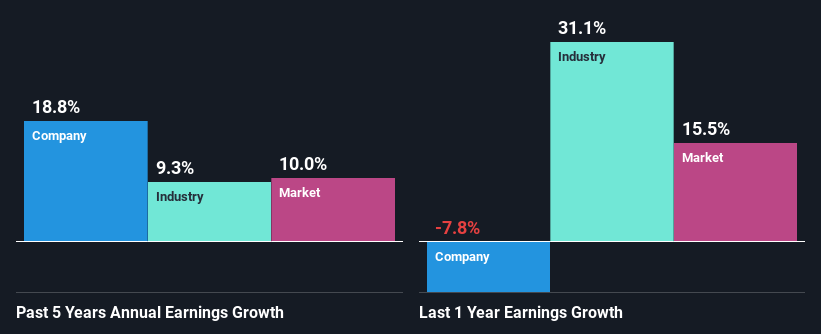Are Robust Financials Driving The Recent Rally In Bloomsbury Publishing Plc's (LON:BMY) Stock?
Most readers would already be aware that Bloomsbury Publishing's (LON:BMY) stock increased significantly by 17% over the past three months. Since the market usually pay for a company’s long-term fundamentals, we decided to study the company’s key performance indicators to see if they could be influencing the market. Particularly, we will be paying attention to Bloomsbury Publishing's ROE today.
Return on Equity or ROE is a test of how effectively a company is growing its value and managing investors’ money. Simply put, it is used to assess the profitability of a company in relation to its equity capital.
Check out our latest analysis for Bloomsbury Publishing
How To Calculate Return On Equity?
The formula for ROE is:
Return on Equity = Net Profit (from continuing operations) ÷ Shareholders' Equity
So, based on the above formula, the ROE for Bloomsbury Publishing is:
10% = UK£18m ÷ UK£182m (Based on the trailing twelve months to August 2022).
The 'return' is the profit over the last twelve months. So, this means that for every £1 of its shareholder's investments, the company generates a profit of £0.10.
What Has ROE Got To Do With Earnings Growth?
Thus far, we have learned that ROE measures how efficiently a company is generating its profits. We now need to evaluate how much profit the company reinvests or "retains" for future growth which then gives us an idea about the growth potential of the company. Assuming all else is equal, companies that have both a higher return on equity and higher profit retention are usually the ones that have a higher growth rate when compared to companies that don't have the same features.
Bloomsbury Publishing's Earnings Growth And 10% ROE
To start with, Bloomsbury Publishing's ROE looks acceptable. Further, the company's ROE is similar to the industry average of 10%. Consequently, this likely laid the ground for the decent growth of 19% seen over the past five years by Bloomsbury Publishing.
Next, on comparing with the industry net income growth, we found that Bloomsbury Publishing's growth is quite high when compared to the industry average growth of 9.3% in the same period, which is great to see.
The basis for attaching value to a company is, to a great extent, tied to its earnings growth. It’s important for an investor to know whether the market has priced in the company's expected earnings growth (or decline). This then helps them determine if the stock is placed for a bright or bleak future. Is Bloomsbury Publishing fairly valued compared to other companies? These 3 valuation measures might help you decide.
Is Bloomsbury Publishing Using Its Retained Earnings Effectively?
Bloomsbury Publishing has a three-year median payout ratio of 43%, which implies that it retains the remaining 57% of its profits. This suggests that its dividend is well covered, and given the decent growth seen by the company, it looks like management is reinvesting its earnings efficiently.
Additionally, Bloomsbury Publishing has paid dividends over a period of at least ten years which means that the company is pretty serious about sharing its profits with shareholders. Based on the latest analysts' estimates, we found that the company's future payout ratio over the next three years is expected to hold steady at 47%. Accordingly, forecasts suggest that Bloomsbury Publishing's future ROE will be 12% which is again, similar to the current ROE.
Summary
In total, we are pretty happy with Bloomsbury Publishing's performance. Specifically, we like that the company is reinvesting a huge chunk of its profits at a high rate of return. This of course has caused the company to see substantial growth in its earnings. With that said, the latest industry analyst forecasts reveal that the company's earnings growth is expected to slow down. To know more about the latest analysts predictions for the company, check out this visualization of analyst forecasts for the company.
Have feedback on this article? Concerned about the content? Get in touch with us directly. Alternatively, email editorial-team (at) simplywallst.com.
This article by Simply Wall St is general in nature. We provide commentary based on historical data and analyst forecasts only using an unbiased methodology and our articles are not intended to be financial advice. It does not constitute a recommendation to buy or sell any stock, and does not take account of your objectives, or your financial situation. We aim to bring you long-term focused analysis driven by fundamental data. Note that our analysis may not factor in the latest price-sensitive company announcements or qualitative material. Simply Wall St has no position in any stocks mentioned.
Join A Paid User Research Session
You’ll receive a US$30 Amazon Gift card for 1 hour of your time while helping us build better investing tools for the individual investors like yourself. Sign up here

 Yahoo Finance
Yahoo Finance 
